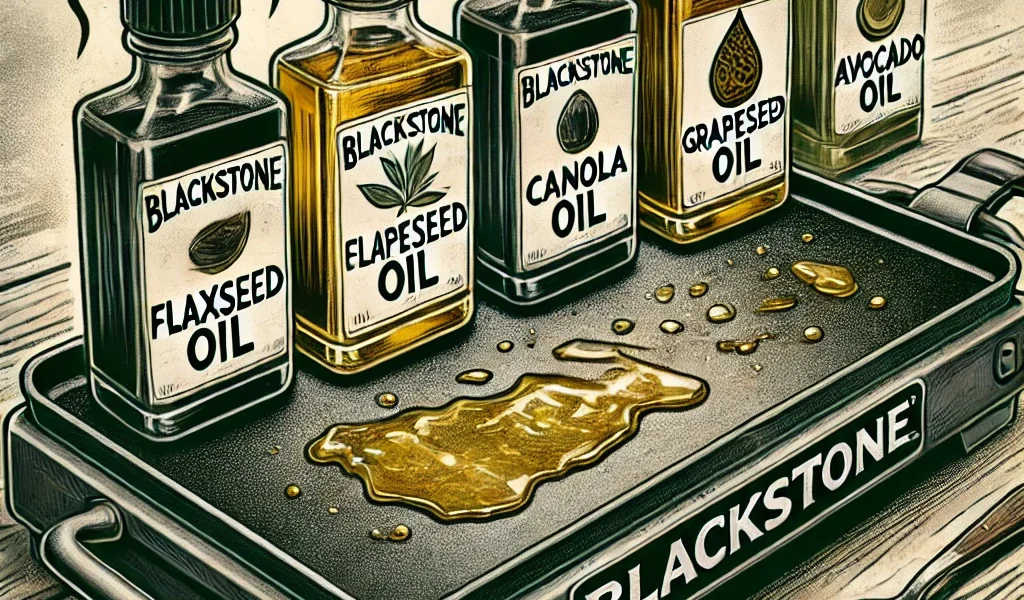What is the Best Oil to Season a Blackstone Griddle?
Introduction
A Blackstone griddle is an excellent outdoor cooking tool, known for its versatility and durability. However, like any piece of cast iron or carbon steel cookware, proper care is essential to maintaining its performance and longevity. One crucial step in this maintenance routine is seasoning your griddle. Seasoning forms a protective layer on the surface, preventing rust, enhancing non-stick properties, and improving the flavor of the food you cook.
The key to successfully seasoning a Blackstone griddle is choosing the right oil. But with so many options available, it can be confusing to determine which oil is best suited for the task. In this article, we will explore the best oils to season a Blackstone griddle, why seasoning is important, and how to properly season your griddle for long-lasting use.
What is Seasoning?
Seasoning refers to the process of applying a thin layer of oil to the surface of a griddle or cast iron cookware and then heating it. As the oil heats up, it undergoes a chemical change called polymerization, bonding with the metal to form a durable, protective layer. This layer prevents rusting, adds a natural non-stick surface, and enhances the flavor of food.
When you first purchase a Blackstone griddle, it typically comes unseasoned, meaning it needs to be seasoned before use. Regular re-seasoning is also recommended after extended use or when the non-stick surface begins to wear down.
Characteristics of a Good Seasoning Oil
Before diving into the best oils to season your Blackstone griddle, it’s important to understand the characteristics of an ideal seasoning oil. Here’s what to look for:
- High Smoke Point: The smoke point is the temperature at which an oil begins to break down and smoke. For seasoning, you’ll want an oil with a high smoke point, as the oil needs to heat to a high temperature to bond with the griddle’s surface effectively.
- Neutral Flavor: Some oils have strong flavors that can be transferred to the food you cook. It’s best to choose an oil with a neutral flavor to ensure it doesn’t overpower the taste of your meals.
- Polymerization: The oil should be able to polymerize well, meaning it should bond with the surface to form a hard, protective coating. Oils that are rich in unsaturated fats are best for this.
The Best Oils to Season a Blackstone Griddle
Now that we know what makes a good seasoning oil, let’s explore some of the best options:
1. Flaxseed Oil
- Smoke Point: 225°F (107°C)
- Why it’s Great: Flaxseed oil is often considered the gold standard for seasoning cast iron and carbon steel griddles. It has a low smoke point, which means it polymerizes effectively at relatively low temperatures. This oil forms a hard, durable layer on the surface of your Blackstone griddle, ensuring long-lasting protection.
- Drawbacks: Flaxseed oil can be expensive compared to other oils, and it may require more frequent applications to maintain the seasoning.
2. Canola Oil
- Smoke Point: 400°F (204°C)
- Why it’s Great: Canola oil is a popular choice for seasoning because it is affordable, has a relatively high smoke point, and is easy to find. It works well for forming a smooth, non-stick coating on the griddle’s surface.
- Drawbacks: While canola oil does a good job of seasoning, it may not form as hard of a coating as flaxseed oil.
3. Grapeseed Oil
- Smoke Point: 420°F (216°C)
- Why it’s Great: Grapeseed oil has one of the highest smoke points among commonly used oils, making it ideal for seasoning a Blackstone griddle, especially when you need to heat it to high temperatures. It also has a neutral flavor, ensuring that it won’t alter the taste of your food.
- Drawbacks: Grapeseed oil is slightly more expensive than canola or vegetable oil, but its performance in seasoning is worth the investment.
4. Vegetable Oil
- Smoke Point: 400°F (204°C)
- Why it’s Great: Vegetable oil is another accessible and affordable option that works well for seasoning a griddle. It has a decent smoke point and creates a smooth non-stick surface. It’s also versatile enough for both cooking and seasoning.
- Drawbacks: Like canola oil, vegetable oil may not create as hard or long-lasting a surface as flaxseed or grapeseed oil.
5. Sunflower Oil
- Smoke Point: 440°F (227°C)
- Why it’s Great: Sunflower oil is a great option due to its high smoke point and neutral flavor. It performs well under high heat, making it suitable for griddle seasoning, and it’s relatively affordable.
- Drawbacks: Like other oils with a high smoke point, sunflower oil may not form as thick or durable of a coating as flaxseed oil.
6. Avocado Oil
- Smoke Point: 520°F (271°C)
- Why it’s Great: Avocado oil has one of the highest smoke points of any cooking oil, making it ideal for seasoning at high temperatures. It’s a healthy option as well, rich in unsaturated fats that contribute to a solid polymerized layer on the griddle.
- Drawbacks: Avocado oil is generally more expensive than other oils and may not be as readily available in all areas.
How to Properly Season Your Blackstone Griddle
Now that you know the best oils for seasoning, here is a step-by-step guide to properly season your Blackstone griddle:
1. Clean the Griddle Surface
Before applying any oil, ensure the griddle surface is clean. Use soap and water to remove any factory coating or residue from the surface. Dry the griddle thoroughly to prevent rust.
2. Heat the Griddle
Turn on your Blackstone griddle and let it heat up for 10-15 minutes. This opens the pores of the metal, allowing the oil to bond more effectively.
3. Apply a Thin Layer of Oil
Once the griddle is hot, use a pair of tongs and a paper towel or cloth to apply a thin layer of your chosen oil to the surface. Be sure to coat the entire griddle, including the edges and corners.
4. Allow the Oil to Smoke
Let the griddle heat until the oil begins to smoke. This means the oil is polymerizing and bonding with the metal surface. After the oil stops smoking, turn off the heat and let the griddle cool.
5. Repeat the Process
For a strong, durable seasoning layer, repeat the oiling and heating process 2-3 more times. This will build up a good non-stick surface and protect the griddle from rust.
6. Maintain the Seasoning
After each use, clean the griddle with water and a scraper, and apply a light layer of oil to maintain the seasoning and prevent rust.
Conclusion
Choosing the right oil to season your Blackstone griddle is key to maintaining its performance and extending its life. Oils like flaxseed, grapeseed, canola, and avocado oil are excellent options, each with their own unique advantages. Proper seasoning forms a protective, non-stick layer on your griddle, making it easier to cook on and clean.
By following the correct seasoning process and using the right oil, your Blackstone griddle will remain a durable and versatile tool for all your outdoor cooking adventures.




